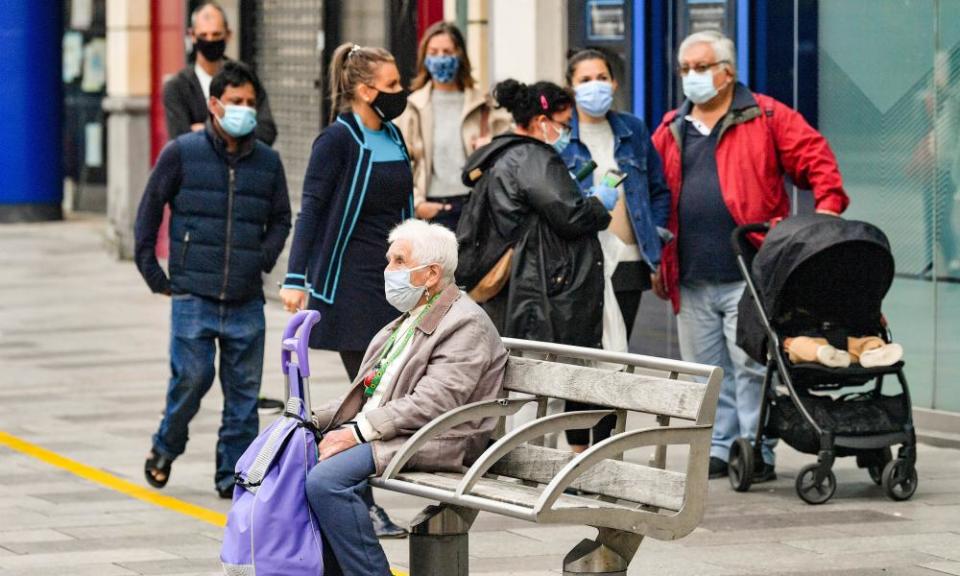Q&A: what does the government's latest UK Covid-19 data reveal?

What do the latest numbers say?
With infections still on the rise, and sharply in some regions, it is clear that the latest restrictions brought in to suppress the virus have either yet to take effect or have not gone far enough. On Wednesday, a further 7,108 new cases were recorded, slightly down on the previous day’s 7,143, but high enough to show that the epidemic continues to grow at pace. There were 71 reported deaths for the second day in a row.
Is it as bad as the spring?
With the first wave of infections, testing was minimal and so the number of infections recorded each day was only the tip of the iceberg. The infection rate today is a more accurate reflection of the size of the epidemic, but still many cases are being missed. Back in March and April there may have been more than 100,000 new infections per day. That compares with the Office of National Statistics’ estimation of around 10,000 cases per day now. At the press conference on Wednesday Prof Chris Whitty, chief medical officer for England, and Sir Patrick Vallance, the government’s chief scientific adviser were challenged about whether their earlier predictions for a second wave had been too gloomy – with as many as 200 people a day dying by mid-November – but they broadly stuck to their guns saying that the second wave could very easily and quickly escalate out of control.
How is the outbreak different this time?
In the spring, the UK was one of the few countries in Europe to experience a broadly nationwide outbreak. In Italy and Spain, the outbreaks were extensive, but more regional. The latest data shows that in England, cases are rising unevenly this time around, at least for now.
The worst hit areas are the north-west, the north-east, Yorkshire and Humber, and parts of the West Midlands. The rises have triggered strict local lockdowns, but it is clear that the country as a whole is in a precarious position. Whitty was far from upbeat about the prospects of containing the virus in a handful of regions. “We’ve got a long winter ahead of us,” he said.
Is the outbreak still led by younger people?
While younger people are still recording the most new infections, as seen in other countries, these infections then spread into older, more vulnerable groups, with an inevitable rise in hospitalisations, admissions to intensive care, and sadly deaths. The most striking rises are in the 19 to 21-year-olds where the weekly percentage testing positive for the virus has doubled to nearly 13% in September alone. Better news is that infections are broadly flat in school-aged children.
What is the impact on older people?
Throughout the pandemic there has been a steady stream of voices advocating to let the virus rip through the young and healthy in the hope of building herd immunity and ultimately allow a return to life as normal. But many scientists have countered that as cases rise, so will deaths. The latest charts show that the surge in cases in England has been followed by an upswing in hospital admissions. Since the end of August, admissions have risen steeply among the most elderly, the 85-year-olds and over, with the proportion taken in to care quadrupling to from three to 13 per 100,000. The rise in admission was nearly as steep among the 75 to 84-year olds. But smaller upticks were also seen in much younger people, all the way down to the 15 to 44-year-old group.
More people in hospital has driven a further surge in admissions to high dependency and intensive care units, with the 65s and over experiencing the sharpest rise, but others in the 45 to 64 age bracket also being admitted. In line with Covid-19 hotspots, the north-west, north-east and Yorkshire are bearing the brunt of hospital admissions, but the Midlands and London show clear rises too.
Is another national lockdown looming?
Boris Johnson made clear that he is loathe to order a second national lockdown.
He appealed for forbearance, but announced no new measures to contain the virus, much to the frustration of some. “What is going to be different next week compared to last week? No new support for people to isolate. No addressing the curfew crowds,” tweeted Susan Michie, professor of health psychology at UCL, and a member of the behavioural science subgroup of Sage.
Some scientists advising the government have not held back in calling for more severe restrictions. Prof John Edmunds, a member of Sage at the London School of Hygiene and Tropical Medicine, has said that ministers are again doing too little, too late, to control the epidemic. The government’s chief scientific advisor did not mince his words. “Things are definitely headed in the wrong direction,” he said of the rising cases, adding that it would be wrong to think of the epidemic as a problem only in certain areas. “There is evidence of spread everywhere and everyone needs to take precautions across the country,” he said.

 Yahoo News
Yahoo News 